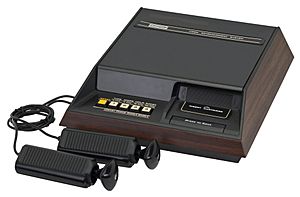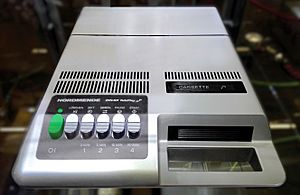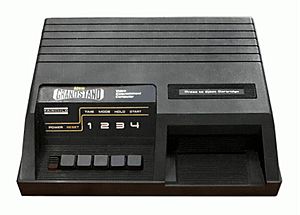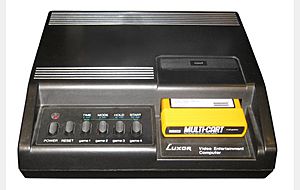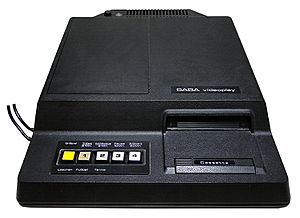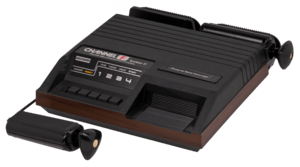Fairchild Channel F facts for kids
The Fairchild Channel F is a classic video game console for your home. It's also known simply as the Channel F. The 'F' in its name stands for 'Fun'!
An engineer named Jerry Lawson designed this console. It came out in November 1976 from a company called Fairchild Camera and Instrument. It cost about $170 back then. This console was super special. It was the very first one to use game cartridges! It was also the first console to use a microprocessor, which is like the brain of a computer. By 1977, about 250,000 Fairchild Channel F consoles were sold. The company stopped making them in 1983.
Contents
Different Versions Around the World
Many different versions of the Fairchild Channel F were sold in Europe. These were made by other companies under a special agreement.
For example, in Sweden, it was called the Luxor Video Entertainment System. In the United Kingdom, it was the Adman Grandstand. Germany had versions like the Saba Videoplay, Nordmende Teleplay, and ITT Tele-Match Processor. In Italy and Belgium, it was known as the Dumont/Barco Videoplay.
Games You Could Play
A total of 26 official game cartridges were made for the Fairchild Channel F. Some of these cartridges even had more than one game on them! Each game cartridge cost about $20.
Years later, on November 5, 2009, a special game was released by fans. This was a version of the popular game Pac-Man. Games made by fans are sometimes called homebrew games.
List of Games
Here is a list of the games released for the Fairchild Channel F:
- Integrated with console: Hockey, Tennis
- Videocart-1: Tic-Tac-Toe, Shooting Gallery, Doodle, Quadra-Doodle
- Videocart-2: Desert Fox, Shooting Gallery
- Videocart-3: Video Blackjack
- Videocart-4: Spitfire
- Videocart-5: Space War
- Videocart-6: Math Quiz (Addition & Subtraction)
- Videocart-7: Math Quiz (Multiplication & Division)
- Videocart-8: Mind Reader, Nim (also called Magic Numbers)
- Videocart-9: Drag Strip
- Videocart-10: Maze, Cat and Mouse
- Videocart-11: Backgammon, Acey-Deucey
- Videocart-12: Baseball
- Videocart 13: Robot War/Torpedo Alley
- Videocart-14: Sonar Search
- Videocart-15: Memory Match
- Videocart 16: Dodge-It
- Videocart-17: Pinball Challenge
- Videocart-18: Hangman
- Videocart-19: Checkers
- Videocart-20: Video Whizball
- Videocart-21: Bowling
- Videocart-22: Slot Machine
- Videocart-23: Galactic Space Wars
- Videocart-24: Pro-Football
- Videocart-25: Casino Poker
- Videocart-26: Alien Invasion
- Videocart-27: Pac-Man (homebrew game)
How the Console Worked
The Fairchild Channel F had some interesting technical features for its time.
- Memory (RAM): It had 64 bytes of RAM. This is a very small amount compared to today's devices.
- Video Memory (VRAM): It also had 2 kilobytes of VRAM. This memory was used to store the images you saw on the screen.
- Processor (CPU): The console's brain was a Fairchild F8 CPU. It ran at a speed of 1.79 MHz.
- Screen Quality: The games were shown in a resolution of 128 × 64 pixels. This means the picture was made up of 128 dots across and 64 dots down. It could display eight different colors.
- Sound: The console could make three basic tones: 500 Hz, 1 kHz, and 1.5 kHz. These tones could be mixed to create more sounds. The sound came from speakers built right into the console, not through your television.
- Controls: It came with two special game controllers. These controllers were permanently attached to the console.
The Next Version of the Console
In 1979, an updated version of the console was released. It was called the Fairchild Channel F System II.
Images for kids
See also
 In Spanish: Fairchild Channel F para niños
In Spanish: Fairchild Channel F para niños



